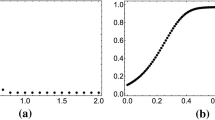Abstract
We give optimal conditions concerning the range of interactions for the absence of spontaneous breakdown of continuous symmetries for one- and two-dimensional quantum and classical lattice and continuum systems. For a class of models verifying infrared bounds our conditions are necessary and sufficient. Using the same techniques we obtain “a priori” bounds on clustering for systems with continuous symmetry, improving results of Jasnow and Fisher.
Similar content being viewed by others
References
A. Klein, L. J. Landau, and D. Shucker, On the absence of spontaneous breakdown of continuous symmetry for equilibrium states in two dimensions,J. Stat. Phys. 26:505 (1981).
J. Fröhlich and C. Pfister, On the absence of spontaneous symmetry breaking and of crystalline ordering in two-dimensional systems,Commun. Math. Phys. 81:277 (1981).
C. E. Pfister, On the symmetry of the Gibbs states in two-dimensional lattice systems,Commun. Math. Phys. 79:181 (1981).
R. L. Dobrushin and S. B. Shlosman, Absence of breakdown of continuous symmetry in two-dimensional models of statistical physics,Commun. Math. Phys. 42:31 (1975).
P. A. Martin, A remark on the Goldstone theorem in statistical mechanics, preprint, Lausanne, 1981.
N. D. Mermin, Absence of ordering in certain classical systems,J. Math. Phys. 8:1061 (1967).
N. D. Mermin and H. Wagner, Absence of ferromagnetism or antiferromagnetism in one- or two-dimensional isotropic Heisenberg models,phys. Rev. Letters 17:1133 (1966).
J. Fröhlich, R. Israel, E. H. Lieb, and B. Simon, Phase transition and reflection positivity, I,Commun. Math. Phys. 62:1 (1978); J. Fröhlich, B. Simon, and T. Spencer,Commun. Math. Phys. 50:79 (1976).
D. Jasnow and M. E. Fisher, Decay of order in isotropic systems of restricted dimensionality I, II,Phys. Rev. B 3:895, 907 (1971)
O. A. McBryan and T. Spencer, On the decay of correlations in SO(n)-symmetric ferromagnets,Commun. Math. Phys. 53:299 (1977).
D. Ruelle,Statistical Mechanics, Benjamin, New York (1969).
W. Driessler, L. J. Landau, and J. Fernando Perez, Estimates of critical lengths and critical temperatures for classical and quantum lattice systems,J. Stat. Phys. 20:123 (1979).
S. B. Schlosman, Phase transitions for two-dimensional models with isotropic short-range interactions and continuous symmetries,Commun. Math. Phys. 71:207 (1980).
R. L. Dobrushin, Analyticity of correlation functions in one-dimensional classical systems with slowly decreasing potentials,Commun. Math. Phys. 32:269 (1973).
M. Cassandro and E. Olivieri, Renormalization group and analyticity in one-dimension: A proof of Dobrushin's theorem,Commun. Math. Phys. 80:255 (1981).
L. J. Landau, J. Fernando Perez, and W. F. Wreszinski, Energy gap, clustering and the Goldstone theorem in statistical mechanics,J. Stat. Phys. 26:755 (1981).
Author information
Authors and Affiliations
Additional information
Partially supported by CAPES-PICD.
Partially supported by the CNPq.
Partially supported by N.S.F. under grant MCS 7801433.
Rights and permissions
About this article
Cite this article
Bonato, C.A., Perez, J.F. & Klein, A. The mermin-wagner phenomenon and cluster properties of one- and two-dimensional systems. J Stat Phys 29, 159–175 (1982). https://doi.org/10.1007/BF01020779
Received:
Issue Date:
DOI: https://doi.org/10.1007/BF01020779




